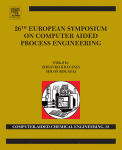 Author(s): Georgios P. Panayiotou, Aikaterini D. Mountraki and Antonis C. Kokossis
Author(s): Georgios P. Panayiotou, Aikaterini D. Mountraki and Antonis C. Kokossis
Affiliation: School of Chemical Engineering, National Technical University of Athens (NTUA), Heroon Polytechniou 9, Zografou Campus GR-15780, Athens, Greece
Reference: Computer Aided Chemical Engineering, vol. 38, 2016, pp. 385-390.
Abstract: “Bioreactors are mainly heterogeneous systems that are strongly non-ideal and operate at mild temperatures with several reversible paths in place. Therefore, mass transfer aspects may become crucial when removing product in the course of reaction, improving, that way, the overall yields. Homogeneous systems are mainly depended on the kinetics and the heat transfer effects. In heterogeneous schemes, on the other hand, the mass transfer and the general hydrodynamic behaviour of the system can become crucial. The overall reaction rate depends on kinetics and on the system’s ability to exchange mass between different phases. Usually, mass transfer and kinetics are balanced. There is a huge potential for innovation and there is strong evidence that non-conventional reactors are capable to bring significant merits. Still, the design of bioreactors is mainly based on experience and heuristics as they are developed for conventional reactors. Moreover, the diversity of feedstock, along with the complicated activity of the microorganisms used, introduce several design uncertainties to consider. Significant systems technology is available to cope with multiple paths but a focus on reaction kinetics much less on mass transfer…”
DOI: 10.1016/B978-0-444-63428-3.50069-2
Comments: as future work, the authors mention “Link with CAPE-OPEN and Aspen Plus for a very accurate chemical properties calculation and fast feed re-characterization is currently being developed.”
